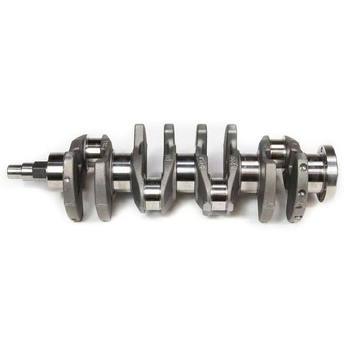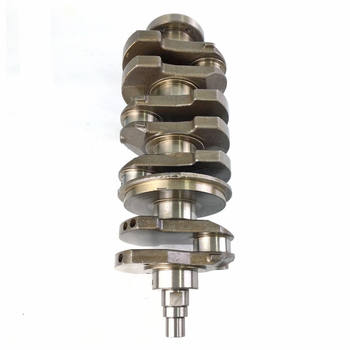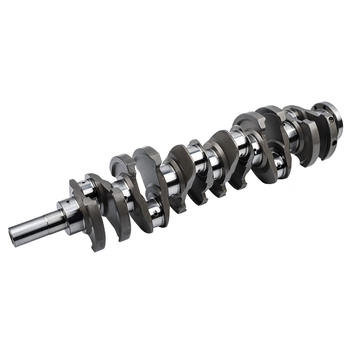Forged vs. Billet vs. Cast: The Definitive Crankshaft Material Comparison Guide
Views :
Update time : 2025-06-09
When it comes to the heart of an internal combustion engine, few components are as critical as the crankshaft. This rotating shaft is responsible for converting the reciprocating motion of the pistons into rotational motion, ultimately driving your vehicle or machinery. But not all crankshafts are created equal. The material and manufacturing process play an enormous role in its strength, durability, and suitability for different applications. Have you ever wondered what truly sets a high-performance engine apart at its core? Often, it boils down to the crankshaft.
In this comprehensive guide, we're going to delve deep into the world of crankshaft manufacturing, specifically focusing on the three primary types: cast, forged, and billet. We'll explore their unique characteristics, how they're made, their inherent strengths and weaknesses, and ultimately help you understand which is best suited for various engine builds, from daily drivers to extreme racing machines. This isn't just about technical specifications; it's about understanding the soul of your engine's power delivery. Frankly speaking, making an informed choice here can be the difference between a reliable powerhouse and a catastrophic failure.
Understanding the Core: What a Crankshaft Does and Why Material Matters
Before we dive into the specifics of forged vs. billet vs. cast, let's briefly reiterate the crankshaft's pivotal role. The crankshaft takes the immense forces generated by combustion in the cylinders and, through connecting rods, transforms them into the rotational energy that propels your vehicle. It's subjected to incredible torsional stress, bending forces, and fatigue cycles, often at extremely high RPMs and temperatures. Given these brutal operating conditions, the material and how it's processed are paramount to its longevity and performance. Interestingly enough, the choice of crankshaft material directly impacts several key aspects of engine design and operation: * Strength: The ability to withstand high loads without deforming or fracturing. * Fatigue Resistance: How well it endures repeated stress cycles over time. * Weight: Lighter crankshafts can allow for higher RPMs and quicker engine response, but often come at a higher cost. * Cost: Manufacturing processes vary wildly in expense, directly affecting the final price. * Machinability: How easily the material can be shaped and finished. Many experts agree that neglecting the crankshaft's characteristics when building or modifying an engine is a common oversight. It's worth noting that even minor imperfections or material weaknesses can lead to significant issues down the line, especially in high-stress applications.Cast Crankshafts: The Economical Workhorse
Cast crankshafts are the most common type found in mass-produced, everyday vehicles. Their prevalence is largely due to their cost-effectiveness and the efficiency of their manufacturing process.How Cast Crankshafts Are Made
The process of creating a cast crankshaft begins with melting iron, typically a high-carbon steel or ductile iron alloy. This molten metal is then poured into a mold that has the exact shape of the crankshaft. Once the metal cools and solidifies, the rough casting is removed from the mold. After casting, the crankshaft undergoes various finishing processes, including machining to achieve precise dimensions, balancing to ensure smooth operation, and sometimes heat treatment to improve certain properties like hardness.
Advantages of Cast Crankshafts
* Cost-Effective: This is by far their biggest advantage. Casting is a relatively inexpensive process, making these crankshafts ideal for budget-conscious production vehicles. * Design Flexibility: Casting allows for complex shapes and internal passages to be easily incorporated into the design, which can be beneficial for oiling or weight distribution. * Good Vibration Damping: The material properties of cast iron can sometimes offer better vibration damping compared to steel, contributing to a quieter engine.Disadvantages of Cast Crankshafts
* Lower Strength: The primary drawback of cast crankshafts is their inherent lower strength and ductility compared to forged or billet counterparts. The crystalline structure formed during casting is more prone to microscopic voids and irregularities, which can act as stress risers. * Brittle Nature: Cast iron is more brittle than steel, meaning it's less tolerant of shock loads and sudden impacts. It tends to fracture rather than bend under extreme stress. * Limited Performance Potential: For high-performance or racing applications where engines operate at extreme RPMs and generate immense power, cast crankshafts are generally not suitable. They simply cannot withstand the forces without a high risk of failure. To be honest, while a cast crankshaft is perfectly adequate for your daily commute, pushing it beyond its design limits in a heavily modified engine is asking for trouble.Forged Crankshafts: The Performance Standard
Forged crankshafts represent a significant step up in strength and durability from cast versions. They are the go-to choice for many performance-oriented production vehicles, as well as a popular upgrade for enthusiasts looking to boost their engine's capabilities.How Forged Crankshafts Are Made
Forging involves taking a solid piece of steel (often a high-strength alloy like 4340 or 5140 steel) and heating it to a high temperature, but below its melting point. The heated steel is then repeatedly hammered or pressed into the desired shape using dies. This mechanical working refines the grain structure of the metal, aligning the grain flow with the shape of the crankshaft. This aligned grain flow is crucial for enhancing the material's strength, ductility, and fatigue resistance. After forging, the crankshaft undergoes extensive machining, heat treatment, and balancing to achieve its final, precise form.
Advantages of Forged Crankshafts
* Superior Strength and Durability: The forging process creates a dense, uniform grain structure that is significantly stronger and more resistant to fatigue than cast iron. This makes forged crankshafts ideal for high-stress applications. * Excellent Fatigue Resistance: Due to the refined grain structure, forged crankshafts can withstand millions of stress cycles without failure, which is critical for long-term engine reliability, especially in performance engines. * Ductility: Unlike brittle cast iron, forged steel is ductile, meaning it can deform slightly under extreme load before fracturing. This provides a margin of safety. * Cost-Effective for Performance: While more expensive than cast, forged crankshafts offer an excellent balance of performance and cost, making them a popular choice for serious engine builders.Disadvantages of Forged Crankshafts
* Higher Cost: The forging process is more complex and labor-intensive than casting, leading to higher manufacturing costs. * Less Design Flexibility: The forging dies are expensive to create, and modifying designs can be costly. This makes it less suitable for low-volume, highly customized applications compared to billet. * More Machining Required: Forged crankshafts often require more extensive machining to achieve final dimensions and balance, adding to the overall production time and cost. In my experience, a forged crankshaft is the absolute minimum requirement for any serious performance build that will see track time or significant power increases. It's a proven technology for optimizing engine durability.Billet Crankshafts: The Pinnacle of Precision and Strength
Billet crankshafts represent the absolute top tier in terms of strength, precision, and customization. They are typically found in extreme racing applications, highly customized engines, or situations where no compromises can be made on performance and durability.How Billet Crankshafts Are Made
Unlike casting or forging, billet crankshafts are machined entirely from a solid block (a "billet") of high-grade steel, often aerospace-quality alloys like 4340, 300M, or even exotic materials. This process, known as CNC machining, uses computer-controlled tools to precisely cut away material from the billet until the crankshaft's final form is achieved. The entire process is highly automated and extremely precise.
Advantages of Billet Crankshafts
* Ultimate Strength and Durability: Machining from a solid billet of premium steel, combined with meticulous heat treatment, results in a crankshaft with unparalleled strength and fatigue resistance. There are no internal voids or grain flow issues as seen in castings, and the material quality can be precisely controlled. * Unmatched Precision: CNC machining allows for incredibly tight tolerances and complex designs that are difficult or impossible to achieve with casting or forging. This precision contributes to better balance, reduced friction, and higher RPM capabilities. * Design Flexibility and Customization: Since no expensive dies are required, billet crankshafts can be custom-designed for virtually any application, engine configuration, or stroke length. This makes them ideal for unique engine builds or prototype development. * Optimized Grain Structure: While not "forged" in the traditional sense, the high-quality billets used often have a fine, uniform grain structure from the initial steel production, which is maintained throughout the machining process.Disadvantages of Billet Crankshafts
* Extremely High Cost: This is the most significant drawback. The raw material is expensive, and the extensive CNC machining time makes billet crankshafts considerably more costly than forged or cast options. * Material Waste: A large amount of material is removed during the machining process, contributing to the higher cost and environmental impact. * Longer Production Time: While automated, the machining process itself can be time-consuming, especially for complex designs. Frankly speaking, a billet crankshaft is an investment reserved for those who demand the absolute best and where every ounce of strength and precision matters. If you're building a drag racing engine or a high-end custom project, this is often the only way to go.Choosing Your Crankshaft: Application, Cost, and Performance
Now that we've explored the distinct characteristics of cast, forged, and billet crankshafts, the big question remains: which one is right for your application? The answer, as with most engineering decisions, depends on a balance of factors. This definitive crankshaft material comparison guide wouldn't be complete without helping you navigate this choice.Consider Your Engine's Intended Use
* Daily Driver/Stock Replacement: For a standard vehicle used for daily commuting or light duty, a cast crankshaft is perfectly adequate and the most economical choice. It's designed to meet the demands of typical driving conditions and provides excellent longevity within its design parameters. * Mild Performance/Street-Strip: If you're building a street car with moderate power upgrades, or one that sees occasional track use, a forged crankshaft is highly recommended. It offers a significant strength increase over cast, providing the durability needed for higher RPMs and increased horsepower without breaking the bank. This is where many enthusiasts find the sweet spot for high-performance engine components. * Extreme Performance/Racing: For dedicated racing applications (drag, road course, marine, etc.) where engines are pushed to their absolute limits in terms of RPM, power, and stress, a billet crankshaft is often the only viable option. Its superior strength, precision, and fatigue resistance are critical for surviving the brutal demands of competitive motorsports.Budget Considerations
The cost differential between these types of crankshafts can be substantial: * Cast: Lowest cost. * Forged: Mid-range cost, typically 2-5 times the price of a cast crankshaft. * Billet: Highest cost, often 5-10+ times the price of a forged crankshaft, depending on material and complexity. It's worth noting that while a billet crankshaft offers the ultimate in performance, it might be overkill and an unnecessary expense for an engine that will never see extreme loads. Conversely, trying to save money by using a cast crankshaft in a high-horsepower build is a false economy that will likely lead to expensive failures.Future Upgrade Potential
Consider your long-term plans for the engine. If you anticipate significant power increases down the road, investing in a stronger crankshaft from the outset can save you time and money in the long run. Swapping a crankshaft later is a major undertaking. I've found that many builders regret not upgrading their crankshaft initially when they decide to push their engine further. This decision plays a crucial role in optimizing engine durability.Conclusion: Making an Informed Decision for Your Engine
Choosing the right crankshaft material is a foundational decision in engine building. Whether you opt for the cost-effective reliability of a cast crankshaft, the robust performance of a forged unit, or the uncompromising strength and precision of a billet masterpiece, understanding the manufacturing processes and inherent properties of each is key. This definitive crankshaft material comparison guide has aimed to equip you with that knowledge. Remember, the crankshaft is not just a component; it's the backbone of your engine's power. Matching the crankshaft to your specific application, power goals, and budget will ensure not only optimal performance but also the longevity and reliability you expect from your engine. Don't underestimate the importance of this critical component.For more detailed information, please visit our official website:crankshaft comparison
About the author: Markus "The Crank" Steel is a seasoned automotive engineer with over two decades of experience specializing in engine design and performance optimization. His expertise spans across various manufacturing processes, from traditional casting to advanced CNC machining. Markus has contributed to numerous high-performance engine builds and is passionate about sharing in-depth knowledge to help enthusiasts and professionals make informed decisions about critical engine components.
Related News
Read More >>
 The Unseen Powerhouse: Unveili
The Unseen Powerhouse: Unveili
06 .12.2025
Explore the vital role of a crankshaft company in powering industries worldwide. Discover their prec...
 Unveiling the Precision: The A
Unveiling the Precision: The A
06 .12.2025
Dive deep into crankshaft manufacturing. Explore the intricate processes, from raw materials to fina...
 Navigating the World of Cranks
Navigating the World of Cranks
06 .12.2025
Discover how to choose the best crankshaft supplier for your needs. Learn about quality, reliability...
 The Unsung Heroes: What Makes
The Unsung Heroes: What Makes
06 .12.2025
Discover the vital role of a crankshaft manufacturer in powering industries. Learn about their preci...
